|
|
|---|
Monday, September 21, 2009

The Imperator has been heard restored to its initial transaction by the establishment Fahrzeugrestaurierung Rosenow, that has now lead to one of the assured gems of the Audi museum mobile bunch in Ingolstadt to shine forth amongst renewed brilliance – the twelve-cylinder Horch 670. Audi Tradition is subsequent to yet again exultant amidst the administered of now bunch of restorers, went by Peter Spillner. As Thomas Frank writes it: “The Audi Imperator looks as if it's fantastic, minimal to the tiniest detail. Our estimates own been heard further as opposed to fulfilled.” Peter Spillner himself is as well content amidst the results: “This was the top issue our establishment has consistently had to face.” Wherever restoration of the car’s ingredients proved to be impossible, new sites had to be calculated and manufactured.” This historic car was found in the German state of affairs of Saxony at the end of the 1990s, and sold by Audi Tradition. Its history is extraordinary to recall: as was presistently the situation in the 1920s, the purchaser (who have got to undergo continued wealthy, ever since the car market values a larger number of as opposed to 16,000 Reichsmarks that much then, as a great deal as a compressed house) bought the Imperator as a chassis investing in engine. This ‘platform’ was delivered to a coachbuilder at which the consumer certain the bodywork of his selection or had it designed. In view of this, Peter Spillner had to conjure up somewhat special. He explains his approach: “We looked at the earliest photographs in the Audi archives and resolved to create an open touring car through a phaeton body.” The colour, too, was founded on detective work: one of the headlights significantly bore traces of the first paint, that is better illustrated somewhere between olive yellow and brown. Spillner, who is 35 decades of age, and his colleagues visited a good number of museums in such a quest for detail authenticity. He recalls: “We studied cars of a comparable age, while all the manufacturers at which instant had the same outside suppliers.” Audi introduced the Imperator at the end of the 1920s as the successor to the innovative Audi Type M six-cylinder model, but it was not destined to be a superior success. The eight-cylinder Imperator appeared correctly in the heart of a phase of boom need for the at that time Audi Werke, that culminated in a takeover by the founder of DKW, Jörgen Skafte Rasmussen, while the arrangement deteriorated much more and more as the universe industry difficulty broke out. Only 145 Audi Imperators got built. Ralf Hornung, who is responsible at Audi Tradition for the obtain and restoration of historic vehicles, explains: “The Imperator was an happy car, but it made it to the sale at the incorrect time.” According to the oldtimer specialist the select car, the endure remaining anywhere in the world, had a extended succession of possessors and more than likely merely survived for a exceptionally special reason. “We suspect such a it there was a rules for it to be depleted by a fire brigade. They are likely to treat this vehicles actually well. The luxury car was unquestionably in passable form when it was sold by Audi. Spillner: “The earliest engine was nonetheless a runner.” The car had a five-litre engine developing 100 horsepower, and multi !no! innovative parts as well. The engine bonnet was formed on aluminium, and carried a “1”, that was Audi’s emblem at which time, surrounded by a thermometer integrated to it. Tyre fluctuations got assembled easy by wheels providing a drastic locking nut, and the car had a special worm-drive rear axle. The Imperator’s chauffeur was when in on a shawm or chalumeau managed by the pressure of the consume gas; continuing to today, their has the commanding tone of a foghorn. It is unlikely the current the the previous surviving Audi Imperator was frequently pressed to utility by the fire brigade, ever since it has just insured a whole of 19,000 kilometres according to the odometer reading. The car has now been heard restored to its former splendour, but Audi Tradition performs not intend for the instant to score it in the Audi museum mobile in Ingolstadt. Thomas Frank, Head of Audi Tradition: “The Audi Imperator ought to initially be reserved for use on special firm occasions.”
Labels: Audi, engine, luxury cars pics, model, special, Vechicles, Wallpapers, wheel
Sunday, September 13, 2009

Aston Martin Racing has released the 2009 specification Vantage GT4 based on Aston Martin's new 4.7 litre V8 Vantage. The new Vantage GT4 builds on the success of its predecessor, the 4.3 litre Vantage N24. The Vantage GT4 has been under development for six months and was unveiled in Dubai this week by Aston Martin chairman, David Richards, and tested extensively at the Dubai Autodrome. The car is an evolution of the N24 with the larger capacity engine being more responsive with increased torque throughout the rev range. The suspension has also been retuned to enhance the handling, including modified front uprights to give increased camber. The 2009 Vantage GT4 also has larger front brake discs with revised cooling.In the last two years, the N24 has proved to be one of the most successful cars in its class; winning the Nurburgring 24 Hours this year, as well as several FIA GT4 races,' said David Richards. 'We have built on this success to develop the Vantage GT4, a competitive racing car for professional and semi-professional drivers, but also a forgiving car which will appeal to enthusiasts who wish to use it for track days and club racing.' The Vantage GT4 is built to FIA GT4 regulations and is eligible to compete in the following series: FIA GT4 European Cup; British GT4 Championship; Britcar Endurance Series; German GT4 Championship; Dutch Supercar Challenge; Dutch GT4 Championship; VLN Endurance Championship at the Nurburgring; Australian Endurance Championship; the American SCCA Championship; and the Aston Martin Owners Club Race Series. The Vantage GT4 comes with either a manual transmission or sportshift transmission. It is priced from £96,645 and is available to order now with delivery in January 2009. Aston Martin Racing is now the only manufacturer to produce cars in each of the GT classes: GT1, GT2, GT3 and GT4.
Labels: Aston Martin, auto, Car Prices, cool car, engine, racing, Release, Series, vantage
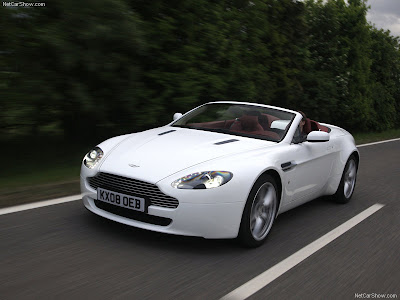
Aston Martin V8 Vantage - originally launched to widespread critical acclaim at the Geneva Motor Show in 2005 - is to receive significant technical enhancements, reaffirming the car's position as one of the world's most desirable and exhilarating sports cars. While the universally distinctive and award-winning shape of the Aston Martin V8 Vantage is retained, the car benefits from a number of technical changes which include significantly up-rated engine performance from a new 4.7 litre power unit in both Coupe and Roadster variants. Other changes include revised dynamics to take full advantage of increased power and torque availability, improved Sportshift™ transmission software and a new sports suspension option. The 4.7 litre V8 engine has a power output of 420bhp (an 11% increase on the previous 4.3 litre unit) and delivers peak torque of 470Nm (15% increase), providing the Aston Martin V8 Vantage with new reserves of mid-range performance, an improved 0-60mph time of 4.7 seconds and top speed of 180mph (288kph). Combined European fuel economy and CO2 emissions are also improved by 13% (Sportshift™). Inside, the changes include a new centre console and revised switchgear and the introduction of an ECU replacing the previous V8 Vantage key. Externally, the acclaimed Aston Martin V8 Vantage design appearance is enhanced with a range of new standard and optional 19'' alloy wheels. Aston Martin Chief Executive Officer, Dr Ulrich Bez said: "Continued development and evolution of our unique VH (Vertical-Horizontal) architecture has brought even higher levels of refinement and dynamic performance to our whole range. "With the new 4.7 litre engine and associated changes we have taken the Aston Martin V8 Vantage to new levels of performance to produce an even more desirable sports car. "The Aston Martin V8 Vantage is now the most successful Aston Martin in our history and we are confident these changes will continue its appeal and driving enjoyment for both new and existing customers." Engine Improvements in performance have been achieved through a number of carefully developed changes to Aston Martin's acclaimed V8 engine. The cylinder bore and stroke has been increased from 89mm to 91mm and 86mm to 91mm respectively, giving a total displacement of 4735cc. The increase in cylinder bore is facilitated by a move to cylinder liners that are pressed into the pre-machined aluminium alloy block, allowing a thinner liner than was possible with the cast-in design of the 4.3 litre engine. The new forged steel crankshaft provides the 91mm stroke and incorporates new holes in the counter weights for reduced rotating mass and improved inter-bay breathing. New forged steel con-rods and cast aluminium pistons complete the capacity-related changes. Other key changes include efficiency improvements to the dry sump lubrication system, including a new sump casting with oil pick-up points moved from the front and rear to the sides of the sump. The cylinder heads are modified with a new intake port and an inlet valve size increase from 34.9mm to 35.9mm. The intake manifold has been modified to match the new port to optimise air flow. Transmission The Aston Martin V8 Vantage transmissions have also undergone changes to improve performance and to handle the increased levels of power and torque. Both the standard manual stick-shift gearbox and the optional Sportshift™ transmission benefit from a modified clutch and flywheel, reducing clutch pedal efforts and delivering a 0.5kg weight saving, reducing the rotating masses within the powertrain, and hence increasing engine responsiveness. Aston Martin's Sportshift™ transmission has undergone a series of specific changes to broaden the capabilities of the gearbox to offer customers enhanced comfort and convenience with sporting capabilities. Changes include a revised control strategy, allowing the transmission, rather than the engine, to dictate how best the engine torque should be deployed to optimise performance and deliver power smoothly and consistently. 'Dual Throttle Map' software is also featured. When 'Comfort' mode is selected the engine reacts in a smoother more progressive manner to driver throttle inputs and in the default 'Sports' mode the throttle mapping is more aggressive, delivering a more dynamic and sporting feel. Sportshift™ now also has the capability to take inputs from the steering wheel enabling the current gear to be held when the car is negotiating a corner and hill descent detection, allowing a low gear to be held, maximising the effects of engine braking. Suspension A series of improvements are introduced to the Aston Martin V8 Vantage chassis and suspension setup to deliver improved body control and low speed ride quality; enabling the driver to take full advantage of the increased performance potential. A number of the improved components originally introduced on the Aston Martin V8 Vantage Roadster are now carried over to the Coupe, including revised upper damper mountings and bump stops. Additionally, the front spring rates are stiffened by 11% at the front and 5% at the rear. Steering geometry is also modified to improve steering feel, while the front lower suspension arm compliance bushes are stiffened by 22% to provide enhanced steering response and handling. The Aston Martin V8 Vantage also now benefits from Bilstein dampers as standard; these low-friction dampers provide improved levels of dynamic capabilities and further improve ride quality. Design & Optional Equipment Also introduced as an option for both Coupe and Roadster variants is a new Sports Pack which comprises forged lightweight alloy wheels aiding a lower unsprung mass, re-tuned Bilstein dampers with improved dynamic response, up-rated springs and a revised rear anti-roll bar (Coupe only). The Sports Pack is intended to offer greater agility, high speed body control and precision feel for the most enthusiastic of drivers. Although the award-winning exterior design of the Aston Martin V8 Vantage remains largely unchanged, a new 20-spoke 19'' alloy wheel is introduced as standard, with either diamond turned silver or graphite finishes available as options, affording customers maximum choice. Alternatively, as part of the Sports Pack option, a 5-spoke lightweight aluminium wheel will be provided. In the cabin, a new centre console constructed from die cast zinc alloy with a graphite silver finish is introduced along with a new ECU - first seen on the Aston Martin DBS in 2007. The ECU - constructed from glass, polished stainless steel and polycarbonate - replaces the key used previously for the Aston Martin V8 Vantage. The revised car also includes a new Hard Disk Drive (HDD) Navigation System offering faster route processing, additional features and improved graphics. Full ipod/MP3 integration is retained as standard equipment. First shown as a concept car at the 2003 North American International Auto Show in Detroit, the Aston Martin AMV8 Concept caused a worldwide sensation as it allowed Aston Martin to enter a new sector of the premium sports car market with a genuine alternative to other cars on offer. Deliveries of the Aston Martin V8 Vantage Coupe to customers began in late 2005, joined by a convertible sibling in 2007 when the Aston Martin V8 Vantage Roadster was launched. The car is hand built at Aston Martin's Headquarters at Gaydon, Warwickshire, UK and to date more than 10,000 have been delivered to customers around the world.
Labels: Aston Martin, auto, Auto show, Concept Cars, convertible, coupe, engine, motor, motor show, sebring, Series, speed, Used Car, vantage, Wallpapers
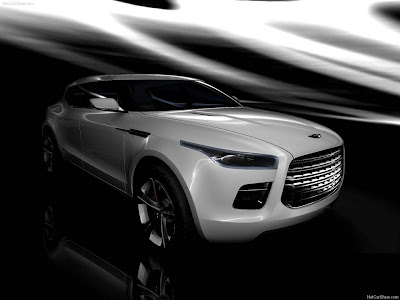
Aston Martin Lagonda concept is celebrating 100 years of manufacturing cars under the brand name Lagonda, stunning modern evolution of this flag name. Lagonda marries modern functionalism with luxury, based on organic forms, rich materials and complex surfaces. The car is based on the best platform, which, taking into account a wide range of future powertrains, including flexfuel, low-emission diesel and hybrid systems. Aston Martin Lagonda concept is composed of four seats in the International Tourer, avant-garde luxury car, which draws inspiration from the outstanding brands the past, as well as the visual language of high-speed design, spacious individualistic environment of higher class cabins and custom feel of contemporary modern furniture. Within four generous seats are divided into two zones, front and rear. As a result, relaxed, rich environment that envelops you in a warm, tactile materials. Marek Reichman, Aston Martin design director, a description of Aston Martin Lagonda concept design language as a synthesis of liquid form mixed with hard, constructed lines. This organic, emotional approach eschews a vertical surface in a broad, flowing around the body and spacious passenger cabin. A clear distinction between cabin, shoulder and flank strongly resembles a powerful and flags lines Lagondas era of 1930's and, in particular the V12 engine option LG6. Viewed from the front of the concept, the deep, strong grating is also the presence and elevation of the cars from the interwar period. Brave character lines that run along the sculpted flanks to the rear to ensure the concept is firmly planted on the road. Large 22 "wheels and cut-out of the body offer exceptional ground clearance, but the concept V12 engine provides power through all four wheels. Modern automotive brand must have strong core values and a wide range of possibilities. Modern Lagonda will lead to long-distance car, a vehicle that combines luxury cosseting extreme functionality and technical innovation. Lagonda name is an integral part of the history of Aston Martin since 1947. Aston Martin Lagonda concept shows how the brand will once again stand together with Aston Martin, as the perfect complement to today's performance. Lagonda stands for functional elegance, performance, simplicity and convenience. "Lagonda will create a new type of relationship with clients, foster the spirit of travel, adventure and style in a single package with a huge," said Dr. Ulrich No. "The agenda for the Aston Martin requirements management. Lagonda required destination. Lagonda: the revival of brand luxury Aston Martin is proud to announce the return of Lagonda, one of the landmark names in the luxury car production. The aim is to Lagonda market with a unique product of luxury performance car that combines exceptional ability with unsurpassed elegance, inside and out. Lagonda return signal a significant expansion of Aston Martin production, taking the company into new and emerging markets worldwide. To demonstrate the vision Lagonda, Aston Martin Lagonda concept car was created, which epitomises the crossing vessels, design and technology with a high-performance Aston Martin examination. Aston Martin Lagonda concept of avant-garde luxury car with a powerful four-wheel drive, four-seat car that will satisfy the most demanding owner. The concept demonstrates the commitment to innovative technologies, new materials and elegant forms. "The Lagonda luxury car is the future," said Aston Martin chief executive, Dr Ulrich Without, "a combination of general convenience, new forms and new technologies and materials." Back Lagonda meets the long term. Aston Martin modern era began in 2001 with the launch V12 win awards and build its headquarters in Gaydon, Warwickshire in 2003. In subsequent years, Aston Martin has started four classes of leading new products, revitalize the GT category and the revision of automotive beauty. Aston Martin range of award-winning DBS, DB9, Vantage and forthcoming quickly, and one-77, represent some of the most beautiful high performance cars are built elegant, highly developed and very well engineered. Aston Martin will always be sports cars, as well as a modern, exclusive and beautiful, it calls for the government, the unique nature of that reward for enthusiasts, both on road and track. First of all, Aston Martin creates an emotional reaction. This machine with a soul. Under the leadership of Dr Ulrich No, Lagonda luxury performance will bring in new markets and territories worldwide. Reflecting its remarkable history, Lagonda will return to Russia, to enter new markets in the Middle East, South America, India and China, as well as in response to demand from a dynamic, innovation-oriented consumers in Europe, North America and the Far East. Not only Lagonda Aston Martin to join the existing core markets, and the unique nature of the new brand will help take the company more than 100 territories worldwide and the expansion of the brand to new customers. "The agenda of Aston Martin is a true, pure sports car," said Dr. Ulrich No, but the Lagonda is something else that the new brand will have access to new markets and have different values for the Aston Martin. " Heritage Lagonda is one of the greatest names in automotive history, brands associated with luxury, performance, grace and exclusivity. Since the first Lagonda production cars was built 100 years ago, born in the United States, Wilbur Gunn, name Lagonda has undergone several incarnations before he soon began to Excel in the creation of racing cars and sports sedans.
Gunn first car was built in his home workshop in Middlesex, England in 1909. In 1910, forced him to Gunn 16/18hp Lagonda Tourer to victory in the Russian judicial Reliability, spectacular developments in the conduct of the Imperial Automobile Club of Russia's public relations exercise in the country's emerging road system. Win brought a lot of orders, and Gunn has focused on the Russian market, the creation of the dealers in St. Petersburg and Moscow in 1910. In truth, Russia's roads, introduced students to the enormous traffic and route, which includes St. Petersburg, Riga, Kiev and Moscow, was a strict test for any car. Gunn is a testament to the success of Lagonda in and build a solid operational performance. It was not until the next year, which began marketing Lagonda cars in the country, starting a limited production of light vehicles, which was eventually stopped by the First World War. Throughout the 20's and 30's the company expanded its premises in Staines, England, taking into account the vehicles yield more substantial touring models. Lagonda came to epitomise Edwardian passion to create new records and exploring new territory, with robust and reliable vehicles that can be easily determined trans-continental links. In 1933, the manufacturer began M45 at Olympia Motor Show in London, sports nutrition from the Tourer Henry Meadows developed six-cylinder 4.5-liter engine. The prototype was driven aristocrat and enthusiast, Edward Russell, Lord de Clifford, from Dieppe in Brindisi to Greece, beating Express on the same route about 14 hours. As a result, it was the media sensation. M45 quickly became known as a vehicle for the discerning sportsman, fast and capable but also quite useful for long journeys. At one time it was the largest engine in its class, the distinction that attracted the owners of the land, as the speed record holder Sir Malcolm Campbell, who was his M45 painted in his signature blue.
The emerging sport of long-distance, endurance racing is also an integral part of Lagonda development. In June 1935, lightweight version of M45 won the Le Mans 24 hours a day, with John Hindmarsh and Luis Fontes at the wheel. This was a landmark achievement for the brand, as well as HighPoint British sports car racing in the interwar period after the heyday of Bentley in 1920-ies. In the same month, was acquired Lagonda Alan Fine, a charismatic British lawyer whose first task was to seek qualified engineer WO Bentley. The results were LG45 Frank Feeley style that represented the pinnacle of engineering skills of time. In 1936, W.O. Bentley developed the first Lagonda V12, the engine, which was perfectly at home in the majestic long-wheeled version of the new chassis. Lagondas in the 1930's demonstrated a general harmony between the engineering and appearance, including the stately LG6 model introduced in 1937. W.O. Bentley good innovation and refinement throughout the war, and the company has developed LG6 model V12, even more imposing and dignified 'cabin, which, unfortunately, ceased production before the war. At the same time, engineers have developed a new six-cylinder engine, the War, the advantages of which were soon on the Aston Martin. Aston Martin Lagonda in collaboration with started in 1947 when David Brown, marque a new owner bought the company for £ 52500. Cooperation has access to the Aston Martin WOBentley new 2.6L DOHC six cylinder engine, as well as the talents of long body stylist Frank Feeley. Feeley is responsible for the elegant drophead version of the new 2.6 liter, the first of the David Brown era Lagonda production from 1948 to 1953. At the end of 1952, the 2.6 liter was developed in 3.0 liters, which is used a revised version of WO Bentley engine. The two-door sedan was soon joined by the four-door coupe and the drophead. Next Lagonda was developed tourist rapid response in 1963, the sleek four-door sedan, which shares many components with the Aston Martin DB4. Fifty-five were built, of which 48 survived. In the late 1960's, Aston Martin head designer William cities, a new four-door sedan from the Aston Martin DBS. Only seven cases have been built in the mid 1970's. In 1976, Aston Martin Lagonda has announced a new era, a unique, innovative car developed by William Cities in the contemporary 'wedge' of fashion, he made his own. Permalink aesthetically and technologically different from the range of Aston Martin, Lagonda was a bold and experimental, high performance luxury saloon a truly discerning. Lagonda name was briefly revived for the Vignale concept, the introduction of a luxury sedan, which was established to develop Ghia in 1993. One example survives. The name is also used for a strictly limited production Virage Lagonda saloon and shooting brakes in 1994. Lagonda stories is a long and eventful, including the two most important figures in twentieth-century British engineers, WOBentley David and Brown, racing fame, and some of the most dramatic designs in automotive history. In the 21 th century, Lagonda will return, bringing a sense of adventure and the avant-garde in the market of luxury cars, in honor of the remarkable history, as well as make a bold statement for the future.
Labels: Aston Martin, Aston Martin DB9, auto, Auto show, Concept Cars, coupe, engine, luxury cars pics, model, motor, motor show, racing, sebring, speed, Used Car, vantage, Vechicles
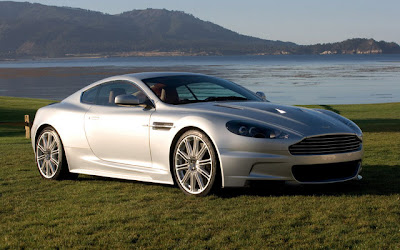
The DBS is manufactured using the finest materials, with a combination of hand-finishing and pioneering high-technology processes. From the exceptional quality of the design and finish to the advanced production techniques employed to save weight and create strength, the DBS is both a technological masterpiece and a powerful visual and tactile experience, inside and out. The DBS is the culmination of the DB bloodline, a synthesis of race-bred technology and road-going practicality that can be traced back to the iconic DB2, DB3S and DB4GT, and is continued today with the DBR9 and DBRS9 race cars. The DBS's powerful, flowing form fuses the visual language of the DBR9 GT1 race car with the innate elegance of the DB series. Lower and tauter than other Aston Martin production models, the DBS has subtly flared wheel arches accommodating standard 20' diameter wheels and tyres. These provide excellent stability and grip, while giving the car a muscular and athletic stance that evokes the DBR9 and DBRS9. The design process involved continuous revision and honing of the DBS's surfaces, ensuring that the shapes and forms represent perfectly the car's inherent power, while never diluting the fundamental proportions that are the essence of every Aston Martin. The external detailing reflects the power and dynamic abilities of the DBS, with revised inlets and enlarged grilles that deliver more air into the engine and increase its cooling capacity. Subtle design details include a new five-bar design for the polished alloy main grille, as well as two additional vents in the enlarged power bulge on the carbon-fibre bonnet. These vents are entirely functional, improving engine performance and efficiency, yet also communicating the increased power output of the uprated V12 engine. The DBS's aerodynamic enhancements are shaped by Aston Martin's racing experience. A carbon-fibre splitter and a new front bumper design help channel airflow around the car's wider bodywork. The aerodynamics team worked hand in hand with the modelling team to ensure that the forms and surfaces of DBS were sculpted for inherent stability at high speeds. The widened front and rear track improve handling and give the car a more muscular character. To accommodate this additional width, the surfaces of the wings have been sculpted and re-shaped with harder lines, which also serve to emphasise the car's strength and power. The lowered ride height is accentuated by the enhanced side sills, carefully profiled to improve aerodynamic performance and reduce drag along the flanks. The iconic Aston Martin side strake, a design feature of every DB car since the DB4, has been redesigned for the DBS, incorporating a side repeater formed by a bank of LEDs. Improved aerodynamics shape the rear of the DBS, where the more prominent boot spoiler is carefully incorporated into the carbon-fibre boot lid. A horizontal chrome finisher is set into the lid to accentuate the wide track of the new car. The car's flat undertray helps to improve the aerodynamics of the underbody surface and culminates in a new carbon-fibre rear diffuser, another feature carried over from the race cars. This device creates an area of low pressure beneath the rear of the car, reducing lift and improving high-speed stability without the need for large, unsightly external spoilers. The new one-piece diffuser also incorporates the DBS's large and distinctive twin exhaust tailpipes. The interior of the DBS represents the epitome of Aston Martin's commitment to using materials honestly, without disguise or embellishment. Lightweight materials are used throughout to save weight; door pulls are made from carbon-fibre, for example, and the carpet has been woven with lighter fibres to save valuable kilograms. Special semi-aniline leather is used throughout the cabin, saving weight as well as giving a soft feel and distinctive aroma. The DBS features unique primary controls, including a new steering wheel profile with a twin-stitched detail marker that indicates the ‘on-centre' position. The gear knob is fashioned from polished alloy to echo the metallic finishes on the new centre console. The instrument cluster is designed with white numerals on a dark graphite background for excellent legibility. The twin-stitch pattern runs through the interior as a signature device; the alignment of both stitch lines is testament to Aston Martin's ongoing tradition of exceptional craftsmanship. The DBS start sequence blends tradition with high technology and a touch of theatre. The ignition ECU (Emotion Control Unit) has evolved into a machined and highly tactile polished sapphire ECU, incorporating a stainless steel inner case. Resembling a fine wristwatch or a piece of contemporary sculptural jewellery, this sapphire ECU epitomises the spirit of the DBS. To operate the car, the sapphire ECU is inserted into a special docking station in Aston Martin's signature dashboard-mounted sapphire starter button, and glows red to indicate when the car is ready to start. The engine is fired by pressing the ECU flush with the surface of the starter button. After pressing to stop the engine, the ECU automatically motors out of the dashboard for removal. The start sequence of the DBS is augmented by an all-new centre console design with a cast metal surround, crisp typography and new graphics. The new console has a traditional dial-face clock at the centre, flanked by two rotary controls for the heating and air-conditioning system, fashioned from solid, turned aluminium. These controls are also used to navigate the audio system, Bluetooth telephone preparation and satellite navigation functions. The Aston Martin 700 W Audio System, with Dolby® Pro Logic II® has been exclusively developed for Aston Martin to provide outstanding sound quality. A slot for the six-CD autochanger is located at the top of the console, while within the centre armrest cubby box there is inbuilt connectivity for MP3 players. Bluetooth telephone preparation is standard on the DBS, enabling you to synchronise your mobile telephone directory through the car's display screens. It can also display the last 10 calls received, made and missed.
Labels: Advanced fast cars, Aston Martin, auto, cool car, engine, model, motor, Need for speed, racing, Series, speed, Used Car, wheel
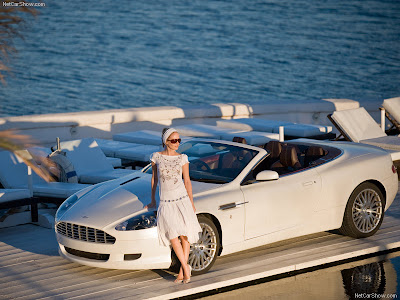
Aston Martin introduced a revised version of the company's critically acclaimed Aston Martin DB9 at the 2008 Geneva Motor Show, which includes significant enhancements to standard specification. These changes include a revised version of Aston Martin's 6.0 litre V12 engine to deliver improved power and torque. Peak power of 470bhp (350kW) - increased by 20bhp (30Nm) - is now reached at 6,000rpm, resulting in a power to weight ratio of 267bhp per tonne (199kW/tonne) - an increase of 11bhp per tonne over the existing Aston Martin DB9. Peak torque of 600Nm is delivered at 5,000rpm, providing even more accessible power for the driver, as well a greater performance feel overall. Accordingly, top speed is now 190mph (306km/h) and the benchmark 0-60mph time improves by 0.3 seconds for the Touchtronic transmission - which benefits from a new valve box and integrated transmission controls to achieve quicker gear shifts - to 4.6 seconds and by 0.1 seconds to 4.6 seconds for the manual gearbox. The latest Aston Martin DB9 also incorporates a series of chassis developments for both the Coupe and Aston Martin DB9 Volante derivates. Bilstein dampers are introduced in addition to revised upper suspension arms and retuned suspension bushes to deliver improved ride quality; aiding greater refinement in the Aston Martin DB9 Volante and an enhanced sporting feel in the Coupe. The Aston Martin DB9 Volante also benefits from revisions to the front shear panel which increases torsional rigidity by 10%, further improving refinement. The Aston Martin DB9 manages to combine all facets of style, quality and usability of a traditional Aston Martin without relying on retrospective detail or design. Accordingly, styling changes to the revised Aston Martin DB9 are subtle, reflecting the car's timeless design and understated elegance. Exterior styling changes include the introduction of a new standard 19'' 10-spoke alloy wheel, new door mirrors and a revised anodised aluminium five-bar grille. In the cabin changes include a new centre console constructed from die cast zinc with a painted iridium silver finish and the introduction of a new Emotion Control Unit (ECU) - first seen on the Aston Martin DBS in 2007. The ECU - constructed from glass, polished stainless steel and polycarbonate - replaces the key used previously for the Aston Martin DB9. The innovative Aston Martin DB9 introduced an exciting new era for Aston Martin. The 2+2 sports car set new standards in its class due to its astonishing combination of technology, agility and design. The car marked the beginning of a new era for Aston Martin and became the first car to be hand-made at the company's state-of-the-art facility in Gaydon, Warwickshire. Sales of the Aston Martin DB9 started in spring 2004, and to date, more than 10,000 examples have been produced and delivered to customers around the world - surpassing the Aston Martin DB7 as the most successful Aston Martin of all time. Deliveries of the updated Aston Martin DB9 begin during quarter two 2008, with prices from £113,950 for the Aston Martin DB9 Coupe and £122,950 for the Aston Martin DB9 Volante
Labels: Aston Martin, Aston Martin DB9, Car Prices, coupe, engine, motor, motor show, sebring, Series, speed, Used Car, Wallpapers, wheel
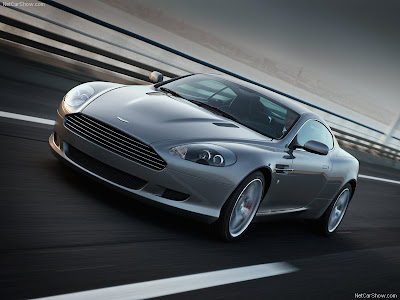
Aston Martin will introduce a revised version of the company's critically acclaimed DB9 at the 2008 Geneva Motor Show, which includes significant enhancements to standard specification. These changes include a revised version of Aston Martin's 6.0 litre V12 engine to deliver improved power and torque. Peak power of 470bhp (350kW) – increased by 20bhp (30Nm) - is now reached at 6,000rpm, resulting in a power to weight ratio of 267bhp per tonne (199kW/tonne) – an increase of 11bhp per tonne over the existing DB9. Peak torque of 600Nm is delivered at 5,000rpm, aiding improved low engine speed and providing more accessible power for the driver, as well a greater performance feel overall. Accordingly, top speed is now 190mph (306km/h) and the benchmark 0-60mph time improves by 0.3 seconds for the Touchtronic transmission – which benefits from a new valve box and integrated transmission controls to achieve quicker gear shifts – to 4.6 seconds and by 0.1 seconds to 4.6 seconds for the manual gearbox. The latest DB9 also incorporates a series of chassis developments for both the Coupe and Volante derivates. Bilstein dampers are introduced in addition to revised upper suspension arms and retuned suspension bushes to deliver improved ride quality; aiding greater refinement in the Volante and an enhanced sporting feel in the Coupe. The DB9 Volante also benefits from revisions to the front shear panel which increases torsional rigidity by 10%, further improving refinement. The DB9 manages to combine all facets of style, quality and usability of a traditional Aston Martin without relying on retrospective detail or design. Accordingly, styling changes to the revised DB9 are subtle, reflecting the car's timeless design and understated elegance. Exterior styling changes include the introduction of a new standard 19'' 10-spoke alloy wheel, new door mirrors and a revised anodised aluminium five-bar grille. In the cabin changes include a new centre console constructed from die cast zinc with a painted iridium silver finish and the introduction of a new Emotion Control Unit (ECU) – first seen on the DBS in 2007. The ECU – constructed from glass, polished stainless steel and polycarbonate - replaces the key used previously for the DB9. The innovative DB9 introduced an exciting new era for Aston Martin. The 2+2 sports car set new standards in its class due to its astonishing combination of technology, agility and design. The car marked the beginning of a new era for Aston Martin and became the first car to be hand-made at the company's state-of-the-art facility in Gaydon, Warwickshire. Sales of the DB9 started in spring 2004, and to date, more than 10,000 examples have been produced and delivered to customers around the world – surpassing the DB7 as the most successful Aston Martin of all time. Deliveries of the updated DB9 begin during quarter two 2008, with prices from £113,950 for the DB9 Coupe and £122,950 for the DB9 Volante.
Labels: Aston Martin, Aston Martin DB9, Car Prices, coupe, engine, motor, motor show, sebring, Series, speed, Used Car, Wallpapers, wheel
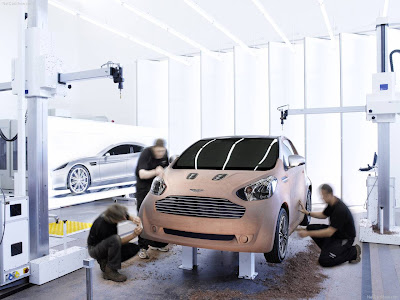
Aston Martin has developed a new luxury commuter concept; the 'Cygnet' which will offer customers a distinctive, intelligent and exclusive solution for urban travel in style and luxury. The concept will offer Aston Martin trademark design in a commuter car package based on the critically acclaimed Toyota iQ with a Euro NCAP 5-star safety package. The 'Cygnet' concept represents a creative, environmentally conscious solution, being small, yet with presence - and highly fuel efficient, now combined with the prestige of Aston Martin's luxury brand ownership. Aston Martin, the world leader in exclusive niche engineering is collaborating on this concept with Toyota the world leader in volume, quality and reliability. Although vastly different in size, Toyota and Aston Martin share the philosophy of engineering excellence and innovation underlined by a strong passion for cars. Aston Martin Chief Executive, Dr Ulrich Bez said: "Now is the right time for Aston Martin to take this first bold step to embark on this special project - made possible with the support of an organisation of Toyota's stature and capability and the intelligent design and perfect city car package of the iQ." "Much work is still required, but I am confident that this project could become reality in the not too distant future. This concept - akin to an exclusive tender to a luxury yacht - will allow us to apply Aston Martin design language, craftsmanship and brand values to a completely new segment of the market." "The offering of a 'Cygnet' with a DBS, DB9 or Vantage is a unique combination of opposites and a novel transport solution allowing intelligent and sensitive mobility on an exclusive and innovative level.
Labels: Aston Martin, Aston Martin DB9, Concept Cars, engine, luxury cars pics, vantage, Wallpapers
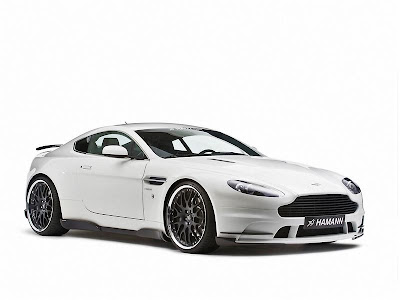
No doubt – HAMANN knows how to refine luxury cars. And with the tuning programme for the V8 Vantage of the English luxury brand Aston Martin, the Laupheim-based company once again confirms its supremacy as a manufacturer of sport accessories and thrilling body design. Optimised aerodynamics in perfect quality 'Form follows function' – in this spirit, HAMANN perfectly co-ordinates the individual components of the aerodynamics kit with each other. The result is an impressive styling with an optimised airflow over the car silhouette and an additional output for increased bend speed. The bow of the Aston Martin can be optionally equipped with a spoiler lip for the original front or enhanced with an entire front skirt. Between the front and rear side, the striking HAMANN side skirt attachments render an integrated design and give the Vantage a lowered and more stretched look. In order to reduce the lifting forces at the back axle, HAMANN technicians developed a shapely spoiler which can be fitted on the rear lid and enhanced with a matching three-part rear diffuser. The latter optically extends the side skirts downwards and skilfully enhances the two end pipes of the HAMANN sport exhaust system. Basically, the customer can choose from two materials for the body components. HAMANN produces its entire aerodynamics programme in fibre glass or optionally in matt carbon. Sportive and elegant – the new light alloy wheel EDITION RACE One of the technical highlights in the tuning programme is the new three-part HAMANN light alloy wheel named EDITION RACE. The forged wheel combines both sportiness as well as elegance. The black varnished rim star and the titanium bolting emphasise the dynamism of the wheel, the highly-polished rim flange on the other hand renders a noble appearance. HAMANN offers the wheel/tyre combination measuring 9,0Jx21 inches with 245/30ZR21 tyres at the front and 10,5Jx21 rims with tyres measuring 295/25ZR21 at the back for 8,540 €. The new aluminium wheels are accentuated with special chassis springs which lower the centre of gravity of the V8 Vantage by 30 mm at the front axle and by 20 mm at the rear axle. At the same time, this enhances the handling of this sports car. HAMANN exhaust components: a successful symbiosis of sound and performance Especially for the V8 Vantage, the Swabian engineers developed sport catalysers and sport end mufflers. The components made of stainless steel render an impressive sound setting and emphasise the sportive value of the HAMANN-makeover. At the same time they breathe an additional 20 hp more performance into the British noble car and this mainly enhances its agility. Stylish interior Produced in the traditional style of Aston Martin which is reflected in comfort, luxury and sportiness in the interior, HAMANN Motorsport offers discreet interior applications. Thus, the noble aluminium pedal set including a foot rest and the car mat set made of threaded pearl velours set sportive trends. If desired, customers can also opt for a handmade complete leather equipment which meets the exclusive demands of Aston Martin drivers.
Labels: Aston Martin, edition, engine, Hamann, luxury cars pics, motor, speed, vantage, Wallpapers, wheel
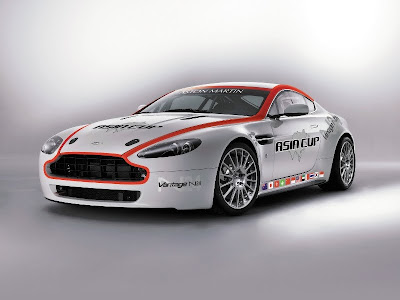
The Aston Martin Vantage N24 is a hand-built racing car, prepared to a bespoke specification by Aston Martin Racing. Aston Martin Asia Cup (AMAC), the series starts in 2008 and will consist of 12 races throughout the Asia Pacific region including China, Japan, Malaysia and Singapore. Each race will feature a grid of 18 Aston Martin Vantage N24s, a 4.3 litre race-developed evolution of the V8 Vantage which has been proven in endurance and sprint races in Europe and the Middle East. The AMAC will include a variety of 30 minute sprint races and longer endurance races, some of which will support Formula One events in the region. The series will provide a stable, well-regulated racing environment with competitive racing in equal equipment provided by the series' organisers. Competitors will be able to ‘arrive and drive' thanks to a comprehensive service package which includes: engineers and technicians, logistical support, hospitality and accommodation, race entry, and a comprehensive spare parts package. Drivers may be able to enter with their own teams, subject to approval by the series organisers. Dr Ulrich Bez, Chief Executive Officer, Aston Martin said: 'When we announced plans to build the Vantage N24 for customers in 2006 we were very confident it would make a great choice for a one-make series. I am delighted that we are able to announce the Aston Martin Asia Cup for 2008, it will help greatly in communicating our brand values, performance, and product durability in this exciting new market.' The Vantage N24 is built to international FIA GT4 regulations by Aston Martin Racing in the UK, who will also provide technical support for the series. The car has a V8 engine producing 410 bhp and weighs just 1350 kg. The 18 AMAC cars have the latest automated manual Sportshift transmission, for fast precise gear shifts, and all the cars are equipped with roll cages, safety fuel tanks, race seats and harnesses, and fire extinguisher systems. The cars will be serviced at the Aston Martin Beijing service facility at the city's Goldenport race circuit. Aston Martin Beijing will be offering a special factory collection option, which will see customers receive expert instruction on the Goldenport track and an opportunity to drive a Vantage N24. The AMAC series director is Ian Ross Geekie. Ian brings a wealth of motorsport experience as a series organiser, team manager and race driver in the Asia Pacific region. Ian has previously worked with several premium automotive marques within Asia, setting up a number of successful and high profile racing championships. In addition to prize money and trophies, the overall winner of the AMAC series will be awarded a sponsored drive in a Vantage N24 in the FIA GT4 series in 2009.
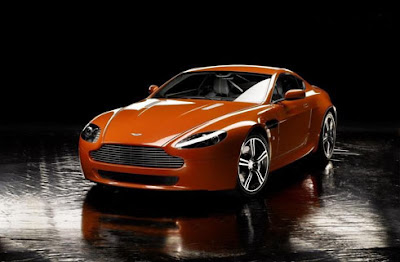
The 2008 Aston Martin V8 Vantage N400 is a gorgeous car. It is seen by car experts as an even more charged version of the previous V8 Vantage that was released by Aston Martin. The car has even more power and is available as both a coupe and a roadster. The Aston Martins are very popular and are loved for both their engines as well as their sleek looks. The Vantage N400 is a special edition vehicle that is as gorgeous and as it is powerful. History of Aston Martin Aston Martin is a British vehicle manufacturer that is cantered in Gaydon, Warwickshire, England. It was started by Robert Bamford and Lionel Martin in 1913. The two men had partnered to sell cars made by Singer in 1912. The two men decided to make their own cars and named their model the Aston Martin after Martin's love of the hill climb races at Aston Hill (which is near Aston Clinton). The first Aston Martin ever produced was a four cylinder Coventry-simplex engine that was on the chassis of an Isotta Fraschini from 1908. The car was made before they managed to acquire manufacturing premises in Kensington at Henniker Place (this happened in 1915). Unfortunately mass production of their cars could not start as soon as the partner's had hoped because of the outbreak of the first World War, which is when Martin joined the Royal Army Service Corps and they sold all of their machinery to the Sopwith Aviation Company. The company was re-founded and revitalized after the war ended when the company received financing from Count Louis Zborowski. Bramford left the company in 1920 but not until they had designed a new car. Over the course of the car's history, Aston Martins have been made to compete in the French Grand Prix (1922); they have set world endurance and speed records at Brooklands. The company has failed two times, once in 1924 and in 1925 with a factory closing taking place in 1926. The company was finally bought by some very rich investors, Lady Charnwood among them, and it was renamed Aston Martin Motors. The company headquarters were moved to Feltham and in 1929 the Aston Martin International racer car was a huge success. In 2007, the company was purchased by David Richards, who is the Prodrive chairman. It is still co-owned by Ford (a development that happened in 1994). The company has also recently opened dealers in Europe and China. Now the company has dealers in 28 countries.
Friday, September 11, 2009
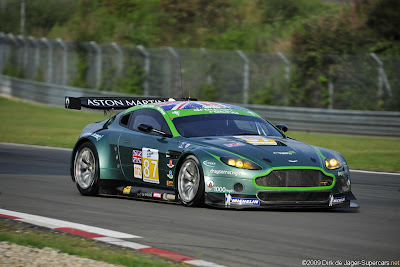
N24 racing car. Originally conceived as a GT4 car, it gradually evolved into a potential GT2 contender, which was the only GT class Aston Martin did not cater for at the time. Early testing at Goodwood showed potential and the GT2 Vantage was officially announced in January of 2008. Customers now had their choice of GT1 (DBR9), GT2 (V8 Vantage), GT3 (DBRS) and GT4 (N24) Aston Martins. While developing the car, the engineers had considerable more room for modifications than with the N24 Vantage, which was virtually stock. What remained unchanged was the advanced bonded aluminum chassis. The double wishbone suspension was also lifted off the road car but the geometry was changed to accommodate for the wider tires. The standard aluminum body, with the exception of the roof, was replaced with lighter and more durable carbon fiber panels. The road car's 4.3 liter V8 engine was increased in size slightly to just under 4.5 liter. This was done to get an intake-restrictor size that best suited the characteristics of the engine. Interestingly Ferrari actually sliced displacement off their F430 V8 engine for the same reason. Although no official figures have been released, we expect the restricted V8 to produce around 480 bhp. The dry-sump competition engine was mated to a six-speed sequential gearbox that was mounted in unit with the differential. Two principles customers were found for the new Aston Martin racing car. In Europe the car would be raced by James Watt Automotive, while Drayson Racing would take one stateside for the American Le Mans Series. Awaiting the arrival of their new car, Drayson campaigned their DBRS9 in the ALMS' opening rounds. The first public appearance of the GT2 Vantage came at the Le Mans Series test at Paul Ricard. The car was clearly still under development but the test gave Aston Martin the opportunity to test the waters against real opposition. The same prototype car was entered in the season opening Catalunya 1000 km race but it was withdrawn after the morning warm-up with engine problems. Later that month the first production car was delivered to Drayson in time for the high profile Long Beach ALMS race. It was considerably off the pace but did manage to reach the finish. The team put on a valiant effort the remainder of the season but continued to struggle to match the competition for pace and reliability. Back in Europe, the prototype made an appearance in the FIA GT test at Spa but did not take part in the 24 Hours later in the month. James Watt Automotive finally took delivery of their V8 Vantage in September and campaigned it in the Le Mans Series season finale at Silverstone. It completed the race in 33rd overall and 8th in class. In October the prototype was raced in two FIA GT races. Facing little opposition, the car won the G2 class at both occasions. Although James Watt Automotive announced a two car entry for the Le Mans Series, Drayson was the only team to race the V8 Vantage in 2009. On the schedule are the Le Mans Series and the major long distance events. The season kicked off at Sebring where the GT2 machine was noticeably quicker but again suffered an engine failure. Back in Europe the team's second V8 Vantage performed better securing an 8th and 6th in class. The next race will the 24 Hours of Le Mans.
Labels: Advanced fast cars, Aston Martin, auto, Auto show, engine, racing, Release, Series, speed, vantage
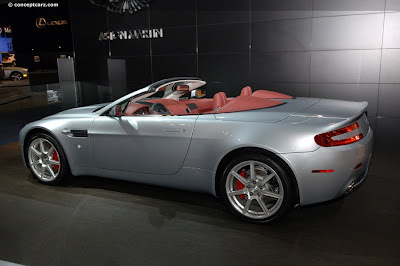
The Aston Martin V8 Vantage is a supreme example of modern automotive design, a hand-crafted sports car that offers exceptional performance, outstanding agility and everyday usability. At the heart of every great sports car is a great engine, and the V8 Vantage Coupe and Roadster are powered by Aston Martin’s 313 kW (420 bhp) 4.7-litre V8, developed for both flexibility and outright performance. The V8 also sounds spectacular and is capable of propelling the car to a maximum speed of 290 km/h (180 mph). Just look at the thing!" That's about the only selling line the 2008 Aston Martin V8 Vantage will ever need. If you've seen a V8 Vantage on the road, you know what we're talking about. Few other cars look this, well, sexy. Thankfully, this baby Aston has impressive talent lurking beneath its gorgeous face. It all starts with Aston Martin's aluminum "VH" platform that also underpins the DB9 and DBS. This intricate assembly of aluminum extrusions, steel and magnesium castings and composite body panels are all bonded together with advance adhesives for light weight and exceptional rigidity. There are other desirable attributes as well, including a rear-mounted transaxle for enhanced weight distribution (49:51, says Aston) and a dry-sump lubrication system for the car's V8 engine. That engine is a 4.3-liter V8 producing 380 horsepower and 302 pound-feet of torque. This is good enough to propel the nearly 3,500-pound Vantage coupe from zero to 60 mph in 5.1 seconds. While this acceleration time is certainly quick, it's not exactly record-breaking -- line up against a BMW M3 and you're in real danger of embarrassment. An Audi R8 and Porsche 911 -- the Aston's principal competitors -- will likewise leave it in their German dust. A glimmer of hope comes in the form of 2008's new N400 trim level. Said to commemorate the company's success with its N24 race car at Germany's Nürburgring racetrack, this more sharply focused V8 Vantage comes with 20 more hp, firmer suspension tuning, lightweight wheels and exterior and interior trim changes. Even in N400 form, this Aston Martin doesn't make much sense from a bang-for-the-buck standpoint. Considering the 911 Carrera S is about $30,000 less, the fiscally conscious should also view the Aston with a very suspicious eye. But there's more to the V8 Vantage than just numbers. In terms of exclusivity, style and character, the V8 Vantage delivers in a big way -- particularly the sexy roadster -- to a degree that no austere German automobile could ever hope to match. And from that standpoint, the V8 Vantage will never disappoint.
Labels: Aston Martin, Aston Martin DB9, auto, coupe, engine, Need for speed, sebring, speed, Used Car, vantage, Wallpapers, wheel
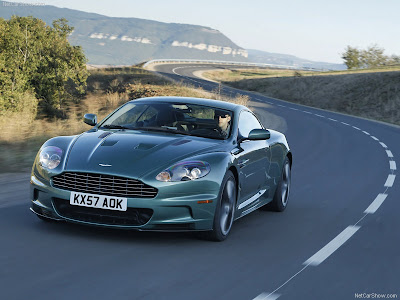
Labels: Aston Martin, racing

Aston Martin unveiled the most eagerly anticipated car of the year the new DBS at the Pebble Beach Concours d'Elegance on August 16th 2007, where the company took a starring role as the featured marque. Aston Martin Chief Executive Officer, Dr Ulrich Bez, said: "The DBS is the ultimate expression of Aston Martin's engineering and technical ability. It offers pure performance without compromise.
The Aston Martin DBS delivers the complete driving experience and bridges the gap between our road and track cars - the Aston Martin DB9 and Aston Martin DBR9." Equally at home on a twisting mountain circuit as on the open road, the DBS is a true thoroughbred. The DBS is a 6.0-litre V12 powered, race-bred, two-seater shaped by the aerodynamic demands of high performance, with an exquisite interior that marries beautifully hand-finished materials with the very latest in performance technology. A combination of elegant design, innovative manufacturing processes, race-derived materials and components and Aston Martin's unrivalled hand-build expertise makes the Aston Martin DBS luxury sports car without equal. Every line, crease and curve conveys the enormous potential of the DBS, a seductive blend of refinement and raw power, provided by the hand-built V12 producing 380kW (510bhp/517PS), a top speed of 191mph (302km/h) and a 0-62mph (0-100km/h) time of 4.3 seconds. The DBS will be built at Aston Martin's global headquarters at Gaydon, near Warwickshire in the UK, joining the current Aston Martin line-up. This now comprises the elegant DB9, the agile Aston Martin V8 Vantage Coupe and the critically acclaimed Aston Martin V8 Vantage Roadster.
DBS: Performance The need for high-performance stability, handling ability and low kerb weight defined the DBS's form and construction. Accordingly, the DBS becomes the first production Aston Martin to make extensive use of ultra-light carbon-fibre body panels. High levels of performance and control are delivered by the combination of inherent light weight, near-perfect weight distribution, a supremely powerful and flexible V12 engine, and a performance-honed six-speed transmission, together with new carbon ceramic brakes and an adaptive damper controlled suspension system. At the heart of the DBS is a 6.0-litre V12 engine. The DBR9 and DBRS9 race cars are powered by an enhanced version of this same V12, tuned to produce in excess of 600bhp. The shared powerplant continues the strong link between Aston Martin's road and race cars, just as the six-cylinder engine used in the DBR1 also powered the Aston Martin DB4, DB5 and DB6 in the 1950s and 60s. As with all current Aston Martins, the engine is hand-assembled at Aston Martin's dedicated engine facility in Cologne, Germany. The classic 6.0-litre V12 features a number of power-increasing enhancements. These include a 'by-pass' engine air intake port that opens above 5500rpm to allow more air into the engine, and re-profiled air inlet ports that further improve airflow into the combustion chamber. Combined with a compression ratio of 10.9:1, the result of these enhancements is prodigious power and torque: the Aston Martin DBS delivers 380 kW (510 bhp/517 PS) at 6500 rpm. The 3.71:1 final-drive ratio ensures that the additional power is usable, enhancing in-gear acceleration in particular.
A lightweight, rigid structure is the design engineer's ultimate goal, and achieving the right balance between strength and mass is crucial. Like the DB9 and its sibling DBR9 and DBRS9 race cars, the DBS uses Aston Martin's class-leading all-alloy VH (Vertical Horizontal) architecture, a lightweight bonded aluminium structure that provides outstanding strength and rigidity. Aston Martin's engineers have also employed advanced materials and processes to further reduce weight and increase the DBS's performance and dynamics. Carbon-fibre panels are used for the boot enclosure, boot lid, door opening surrounds, front wings and bonnet, giving a saving of some 30kg over more conventional materials without any reduction in strength. "There are no restrictions on form or shape in using carbon-fibre," says Marek Reichman, Aston Martin's Design Director, "and the material allowed us to wrap bodywork around the 20" wheels and maintain the precise relationship between the wheel and the bodywork." Each panel has been carefully sculpted to direct the airflow around the car, into the engine and to help cool the braking system. The carbon-fibre elements are produced using advanced manufacturing techniques developed from the aerospace and motorsport industries. The new panel-making procedure also delivers an industry-best surface finish, thanks to a patented 'Surface Veil' process.
The application of a 200 micron layer of epoxy and glass to the panel delivers a class-A surface that is in line with Aston Martin's tradition of high-quality finishes. Inside the car, the weave patterns on the exposed carbon-fibre elements have been carefully selected to present the most harmonious surfaces. DBS: Control As with the DB9 and DBR race cars, the DBS benefits from the inherent characteristics of the VH architecture. The VH underframe consists of pressed, extruded and cast aluminium components, bonded together to create an immensely strong underlying structure. This structure means that weight is kept to a minimum, with the front-mid mounted engine and rear-mid mounted transaxle ensuring a near perfect weight distribution: 85% of the car's weight is positioned within its wheelbase. The DBS's polar moment of inertia is therefore very low, producing a car with natural agility, a strong, stable platform for the V12's high power output and an exhilarating driving experience. To take full advantage of its extremely precise and rigid platform, the Aston Martin DBS employs a new and sophisticated Adaptive Damping System (ADS) which uses two separate valves to set the dampers to five different positions, allowing instant adjustment of the car's ride and handling characteristics. The ADS automatically alters the suspension settings to ensure the driver has high levels of control at all times, with the ability to respond instantly to different driving conditions. The dampers can be 'softer', with a corresponding improvement in ride quality, or 'firm', providing improved body control for more spirited driving. The damper settings are determined by an electronic control unit which takes sensor readings from the car's systems, including throttle position, brake position, steering wheel rotation and vehicle speed. This data establishes the prevailing driving conditions and the demands the driver is making on the car.
The Aston Martin DBS's Adaptive Damping System perfectly captures the car's sporting character, ensuring that stiffer dampers are available for better handling and control when the car is being driven enthusiastically, without compromising ride comfort during 'normal' driving conditions. A designated 'Track' mode automatically sets all dampers to their firmest positions, making it ideal for circuit driving. The DBS is fitted with Pirelli P-Zero tyres that have been developed especially for the car, along with new 20" lightweight alloy wheels. The DBS also has a revised Dynamic Stability Control (DSC) system, designed to help maintain maximum traction in challenging driving conditions. In default operation, the DSC is automatically on. Select and press the button for two seconds and DSC 'Track' mode is engaged, raising the threshold at which the system intervenes to allow the experienced driver to explore the car's limits. Hold the button for four seconds and DSC is disengaged entirely. The car's braking system features another innovation, the first time Carbon Ceramic Matrix (CCM) brakes have been used on a road-going Aston Martin. The end result is shorter stopping distances with excellent resistance to fade in even the most demanding driving conditions. CCM brakes are also some 12.5kg lighter than a conventional system, reducing the weight of the car overall and, in particular, the unsprung weight and rotational masses, further enhancing the performance of the suspension. DBS: Design The DBS is manufactured using the finest materials, with a combination of hand-finishing and pioneering high-technology processes. From the exceptional quality of the design and finish to the advanced production techniques employed to save weight and create strength, the DBS is both a technological masterpiece and a powerful visual and tactile experience, inside and out. The DBS is the culmination of the DB bloodline, a synthesis of race-bred technology and road-going practicality that can be traced back to the iconic Aston Martin DB2, DB3S and DB4 GT, and is continued today with the DBR9 and DBRS9 race cars.
The DBS's powerful, flowing form fuses the visual language of the DBR9 GT1 race car with the innate elegance of the DB series. Lower and tauter than other Aston Martin production models, the DBS has subtly flared wheel arches accommodating standard 20" diameter wheels and tyres. These provide excellent stability and grip, while giving the car a muscular and athletic stance that evokes the DBR9 and DBRS9. The design process involved continuous revision and honing of the Aston Martin DBS's surfaces, ensuring that the shapes and forms represent perfectly the car's inherent power, while never diluting the fundamental proportions that are the essence of every Aston Martin. The external detailing reflects the power and dynamic abilities of the DBS, with revised inlets and enlarged grilles that deliver more air into the engine and increase its cooling capacity. Subtle design details include a new five-bar design for the polished alloy main grille, as well as two additional vents in the enlarged power bulge on the carbon-fibre bonnet.
These vents are entirely functional, improving engine performance and efficiency, yet also communicating the increased power output of the uprated V12 engine. The DBS's aerodynamic enhancements are shaped by Aston Martin's racing experience. A carbon-fibre splitter and a new front bumper design help channel airflow around the car's wider bodywork. The aerodynamics team worked hand in hand with the modelling team to ensure that the forms and surfaces of DBS were sculpted for inherent stability at high speeds. The widened front and rear track improve handling and give the car a more muscular character. To accommodate this additional width, the surfaces of the wings have been sculpted and re-shaped with harder lines, which also serve to emphasise the car's strength and power. The lowered ride height is accentuated by the enhanced side sills, carefully profiled to improve aerodynamic performance and reduce drag along the flanks. The iconic Aston Martin side strake, a design feature of every DB car since the DB4, has been redesigned for the DBS, incorporating a side repeater formed by a bank of LEDs. Improved aerodynamics shape the rear of the DBS, where the more prominent boot spoiler is carefully incorporated into the carbon-fibre boot lid. A horizontal chrome finisher is set into the lid to accentuate the wide track of the new car. The car's flat undertray helps to improve the aerodynamics of the underbody surface and culminates in a new carbon-fibre rear diffuser, another feature carried over from the race cars. This device creates an area of low pressure beneath the rear of the car, reducing lift and improving high-speed stability without the need for large, unsightly external spoilers.
The new one-piece diffuser also incorporates the DBS's large and distinctive twin exhaust tailpipes. The interior of the Aston Martin DBS represents the epitome of Aston Martin's commitment to using materials honestly, without disguise or embellishment. Lightweight materials are used throughout to save weight; door pulls are made from carbon-fibre, for example, and the carpet has been woven with lighter fibres to save valuable kilograms. Special semi-aniline leather is used throughout the cabin, saving weight as well as giving a soft feel and distinctive aroma. The DBS features unique primary controls, including a new steering wheel profile with a twin-stitched detail marker that indicates the 'on-centre' position. The gear knob is fashioned from polished alloy to echo the metallic finishes on the new centre console. The instrument cluster is designed with white numerals on a dark graphite background for excellent legibility. The twin-stitch pattern runs through the interior as a signature device; the alignment of both stitch lines is testament to Aston Martin's ongoing tradition of exceptional craftsmanship. As an option the DBS may be equipped with specially developed lightweight seats (outside North America). These feature a carbon-fibre and Kevlar® composite structure and are manufactured by a supplier to the motorsport and aviation industries before being returned to Aston Martin's Gaydon factory for hand-trimming.
The structure is created by sandwiching a layer of Kevlar® between two layers of carbon-fibre with the outer finish left exposed on the seat backs, lacquered to create a durable and attractive finish. The combination of Kevlar® and carbon-fibre provides crucial weight saving by allowing the structure of the seat to be incredibly slim: between 2.5mm and 3mm. Overall, the trimmed seat provides a weight saving of 20kg.
The lightweight seats are a fixed structure, but can be adjusted for rake as well as sliding fore and aft. The DBS start sequence blends tradition with high technology and a touch of theatre. The ignition ECU (Emotion Control Unit) has evolved into a machined and highly tactile polished sapphire ECU, incorporating a stainless steel inner case. Resembling a fine wristwatch or a piece of contemporary sculptural jewellery, this sapphire ECU epitomises the spirit of the DBS. To operate the car, the sapphire ECU is inserted into a special docking station in Aston Martin's signature dashboard-mounted sapphire starter button, and glows red to indicate when the car is ready to start. The engine is fired by pressing the ECU flush with the surface of the starter button. After pressing to stop the engine, the ECU automatically motors out of the dashboard for removal. The start sequence of the DBS is augmented by an all-new centre console design with a cast metal surround, crisp typography and new graphics.
Labels: Advanced fast cars, Aston Martin, Aston Martin DB9, auto, cool car, coupe, engine, luxury cars pics, model, motor, Need for speed, racing, sebring, Series, speed, Used Car, vantage, wheel
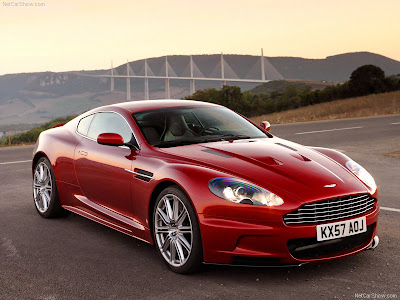
Aston Martin unveiled the most eagerly anticipated car of the year the new Aston Martin DBS at the Pebble Beach Concours d'Elegance on August 16th 2007, where the company took a starring role as the featured marque. Aston Martin Chief Executive Officer, Dr Ulrich Bez, said: "The Aston Martin DBS is the ultimate expression of Aston Martin's engineering and technical ability. It offers pure performance without compromise. The Aston Martin DBS delivers the complete driving experience and bridges the gap between our road and track cars - the Aston Martin DB9 and Aston Martin DBR9." Equally at home on a twisting mountain circuit as on the open road, the DBS is a true thoroughbred. The Aston Martin DBS is a 6.0-litre V12 powered, race-bred, two-seater shaped by the aerodynamic demands of high performance, with an exquisite interior that marries beautifully hand-finished materials with the very latest in performance technology. A combination of elegant design, innovative manufacturing processes, race-derived materials and components and Aston Martin's unrivalled hand-build expertise makes the Aston Martin DBS a luxury sports car without equal. Every line, crease and curve conveys the enormous potential of the Aston Martin DBS, a seductive blend of refinement and raw power, provided by the hand-built V12 producing 380kW (510bhp/517PS), a top speed of 191mph (302km/h) and a 0-62mph (0-100km/h) time of 4.3 seconds. The Aston Martin DBS will be built at Aston Martin's global headquarters at Gaydon, near Warwickshire in the UK, joining the current Aston Martin line-up. This now comprises the elegant DB9, the agile Aston Martin V8 Vantage Coupe and the critically acclaimed Aston Martin V8 Vantage Roadster. Aston Martin DBS: Performance The need for high-performance stability, handling ability and low kerb weight defined the DBS's form and construction. Accordingly, the Aston Martin DBS becomes the first production Aston Martin to make extensive use of ultra-light carbon-fibre body panels. High levels of performance and control are delivered by the combination of inherent light weight, near-perfect weight distribution, a supremely powerful and flexible V12 engine, and a performance-honed six-speed transmission, together with new carbon ceramic brakes and an adaptive damper controlled suspension system.
Labels: Aston Martin, Aston Martin DB9, coupe, engine, luxury cars pics, Need for speed, sebring, speed, vantage, Wallpapers
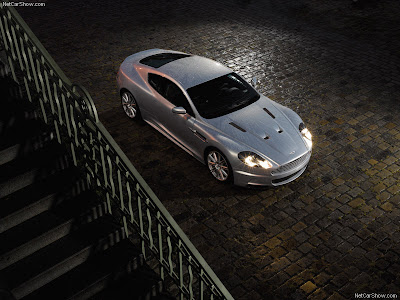
Aston Martin unveiled the most eagerly anticipated car of the year the 2008 DBS at the Pebble Beach Concours d'Elegance on August 16th 2007, where the company took a starring role as the featured marque.
DBS is the ultimate expression of Aston Martin's engineering and technical ability. It offers pure performance without compromise. The DBS delivers the complete driving experience and bridges the gap between our road and track cars - the DB9 and DBR9.
Body
- Two-door coupe body style with 2+0 seating
- Bonded aluminium VH structure
- Aluminium, magnesium alloy and carbon-fibre composite body
- Extruded aluminium door side-impact beams
- High Intensity Discharge (HID) headlamps (main beam)
- LED rear lamps and side repeaters
Engine
- All-alloy, quad overhead camshaft, 48-valve, 5935cc V12.
- Compression ratio 10.9:1
- Front-mid mounted engine, rear-wheel drive
- Fully catalysed stainless steel exhaust system with active bypass valves
- Max power: 380kW (510bhp/517 PS) at 6500rpm
- Max torque: 570Nm (420 lb.ft) at 5750rpm
- Acceleration: 0-100 km/h (0-62mph) in 4.3 seconds
- Max speed: 302 km/h (191mph)
Brakes
- Front: Ventilated carbon ceramic discs, 398mm diameter with six-piston calipers
- Rear: Ventilated carbon ceramic discs, 360mm diameter with four-piston calipers
- Dynamic Stability Control (DSC) with Track mode
- Anti-lock Braking System (ABS)
- Electronic Brakeforce Distribution (EBD)
- Emergency Brake Assist (EBA)
- Traction control
Labels: Aston Martin, Aston Martin DB9
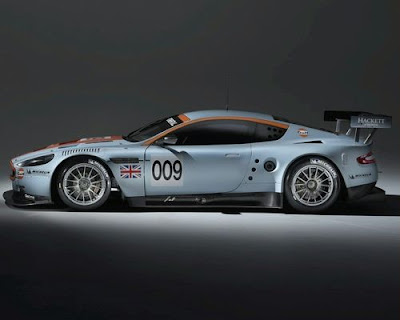
Two Aston Martin DBR9s will look to emulate Gulf's first victory at the 24 hour race 40 years on. Alain Dujean, Gulf Oil vice president international, said: 'This is arguably the most important year ever for Gulf in motorsport. The famous Gulf racing colours first tasted victory at Le Mans in 1968, so 2008 already had great significance for us, but for Gulf to have joined up with Aston Martin Racing for this year is fantastic – the coming together of two great automotive names, for what I hope will be a long and fruitful partnership.' David Richards, chairman of Aston Martin, said: 'Endurance racing is engrained in the heritage of both Gulf and Aston Martin and we have also both been intrinsically linked through Le Mans for many decades. It was perhaps destined that, in the year we defend our GT1 title and Gulf celebrates the 40th anniversary of its win, we would finally race together at La Sarthe.' The two Aston Martin DBR9s for 2008 will be entered as numbers 007 and 009.
Labels: Aston Martin, auto, motor, racing
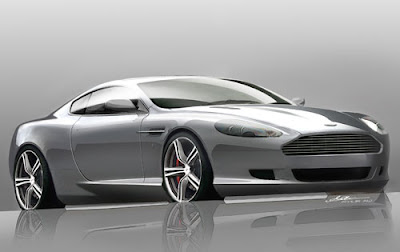
Aston Martin is not only showing the DBS for the first time in Europe at the Frankfurt Motor Show next week but will also showcase two new special editions – the Aston Martin DB9 LM and the V8 Vantage N400. Both special editions draw inspiration from the company's recent achievements at Le Mans and the N?rburgring 24-hour races. The Aston Martin DB9 LM celebrates Aston Martin's GT1 class victory in the Le Mans 24-hour endurance classic in June with the Aston Martin DBR9 - a race car derived from the Aston Martin DB9. This special edition car, available in Coupe form only with Touchtronic transmission, includes a unique Sarthe Silver exterior paint finish, meshes and rear crossbar finished in Magnum Silver and red brake calipers. Inside, the Aston Martin DB9 LM is fitted with handcrafted black leather finish, perforated leather inserts, unique 'Tertre Rouge' facia trim and numbered sill plaque. The car is also equipped with the normally optional DB9 Sports Pack as standard, with colour keyed and diamond turned alloy wheels.
Labels: Aston Martin, Aston Martin DB9, coupe, edition, motor, motor show, sebring, vantage, Wallpapers, wheel
Tuesday, September 8, 2009
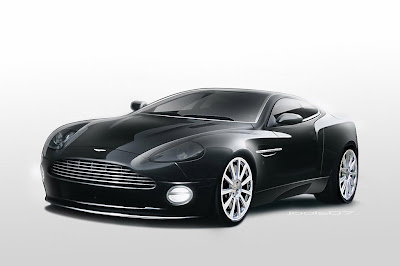
Aston Martin has announced two exciting developments for both new and existing customers of the company's flagship Vanquish S. Just 40 examples of a new Vanquish S Ultimate Edition will be handcrafted at the company's Newport Pagnell production facility in Buckinghamshire. The model represents a luxurious and unique limited edition befitting the Vanquish S's status as the ultimate Aston Martin and also celebrates the skilled craftsmanship of the team working at Newport Pagnell. The Ultimate Edition will be available by special request to customers wishing to celebrate the last of a significant car in Aston Martin's history. Initial feedback suggests the whole allocation of this special edition will be sold within weeks of launch. The Ultimate Edition centres on changes to the Vanquish S's renowned colour and trim. On the exterior, these changes include a unique 'Ultimate Black' - a striking new colour which will only be available with this car. Inside, the Vanquish S cabin is trimmed in a semi-aniline leather, with coarse stitching, leather headlining and black chrome finish interior fittings. Each car will also be fitted with personalised sill plaques denoting the limited edition number. The Vanquish S Ultimate Edition retains all performance capabilities of the standard Vanquish S - and accordingly its position as the fastest ever production Aston Martin, capable of a top speed in excess of 200mph (321km/h). No additional charge will be made for the Ultimate Edition, available only with the 2+2 seating arrangement, priced at £182,095. For existing Vanquish customers, Aston Martin's world renowned Works Service department are to offer a new transmission conversion for owners of the company's flagship model, adding to their reputation for an unparalleled level of personalisation. Serving as a further example of the depth of bespoke services available via Works Service, existing Vanquish owners will now be able to order a transmission conversion from the car's existing Auto Shift Manual (ASM) system, to a conventional stick-shift manual. Working in conjunction with the company's Special Vehicles Operations team from Gaydon, Works Service has developed the system over the last 12 months, before previewing the conversion to selected Vanquish customers. Since its launch in 2001, the Vanquish has been equipped with fingertip controlled, Formula 1-style paddles which enables almost imperceptible gear changes in under 250 milliseconds. Advanced electronics also permit the close ratio six speed manual transmission to be programmed to operate automatically. Drivers with a preference for a conventional stick-shift transmission will now have the option of this new Works Service-only modification which is available to order immediately, with prices commencing from £13,250 (+ VAT). Established as a modern classic, the Vanquish's muscular 2+2 epitomises Aston Martin's core values of power, beauty and soul. It is the ultimate sports car for the discerning owner. Since its launch, the Vanquish has proved to be a huge success for Aston Martin with over 2000 cars delivered to customers around the world. In 2002 the Vanquish graced the screens of millions, starring alongside 007 in the James Bond film 'Die Another Day.' Located at Newport Pagnell in Buckinghamshire, Aston Martin Works Service offers a factory-backed workshop with the experience necessary to care for any Aston Martin or Lagonda with unparalleled skill and attention to detail. With more than 40 years experience, the Works Service team offers accident repair, servicing, maintenance and even full restoration capabilities to Aston Martin and Lagonda owners. In 2006 more than 2000 customers called upon Works Service expertise, a number which is expected to be surpassed again in 2007.
Labels: Advanced fast cars, Aston Martin, auto, Car Prices, edition, model, speed, Vechicles, Wallpapers
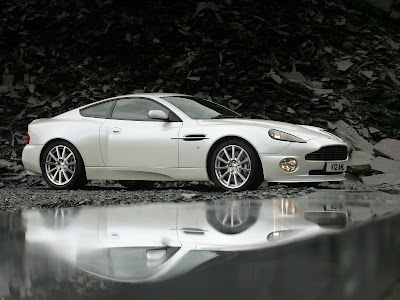
The fastest production model ever to be built by Aston Martin made its world debut at the Paris Motor Show on September 23, 2004. With a maximum speed in excess of 200mph (320 km/h) and a 6.0 litre V12 engine developing 520 horsepower, the Vanquish S has been designed to deliver even greater performance, complemented by subtle suspension and steering changes and a number of interior and external style revisions. The Vanquish S has received subtle but effective changes to complement its elegant muscular body. The famous Aston Martin grille has a new rounded and more open appearance for better cooling, and an aerodynamic splitter improves high-speed stability. At the rear, a redesigned boot lid featuring a new high mounted stop lamp reduces lift and improves balance and stability, helping to achieve an impressive Cd figure of 0.32. These differences on the Vanquish S not only improve the appearance but also enhance performance. All the exterior body panels are constructed from aluminium with each individual panel hand tailored to the central structure to ensure a perfect panel fit. Every carefully detailed feature provides graphic evidence of the painstaking craftsmanship and quality, which is invested in its construction at Aston Martin?s Newport Pagnell site in Buckinghamshire. Revised steering geometry provides a 20% quicker response, allowing the driver to apply a reduced input for required steering response. This enables the driver to be more precise with inputs - especially on winding roads - and more accurate feedback from the chassis. The Sports Dynamics suspension, steering and braking package is now standard on the Vanquish S. This includes stiffer springs and dampers and shorter steering arms. The brakes have been upgraded to incorporate larger six piston calipers and larger grooved and ventilated front discs. The rear discs are 2mm wider for improved heat dissipation. The use of floating discs ensures the driver has consistent pedal feel under heavy braking whilst a new brake pedal assembly reduces travel and enhances pedal feel. Further development of Aston Martin?s low emissions, all alloy, quad-overhead camshaft, 48 valve, 6.0-litre V12 engine has generated an increase in power from 460 bhp to 520 bhp and torque is boosted to 425 lb ft (577 Nm). Engine enhancements include new cylinder heads with fully machined inlet ports and combustion chambers to improve airflow, revised engine mapping and new fuel injectors. The overall interior design is a subtle blend of traditional, classic and modern materials with Bridge of Weir leather upholstery matched to contemporary metal interior fittings and finishes. A number of detailed improvements have been made to the interior of the Vanquish S to enhance the enhance the overall appeal.
Labels: Aston Martin, blogspot, cool car, engine, model, motor, motor show, speed, Wallpapers
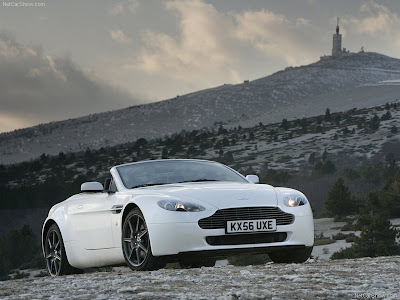
Aston Martin will unveil one of the most eagerly anticipated convertibles of the year when the V8 Vantage Roadster is revealed at the 2006 Los Angeles Auto Show on Wednesday 29th November. Aston Martin Chairman and Chief Executive Officer, Dr Ulrich Bez said: 'The V8 Vantage Roadster is a pure sports car, a car that heightens the senses and provides a dynamically thrilling driving experience. 'The Vantage Roadster adds to the unbeatable thrill of open air motoring and by combining engineering excellence, technological innovation and physical perfection, will ensure every journey is one to remember.' Perfectly proportioned, with a low purposeful stance, the Vantage Roadster is uncompromisingly modern yet also incorporates classic Aston Martin design cues. The elegant lines are fused with traditional craftsmanship and striking 21st century style, with an interior hand-trimmed and finished in the finest quality genuine materials. The Vantage Roadster will be built at Aston Martin's global headquarters at Gaydon, near Warwickshire in the UK, joining the current Aston Martin line-up. This now comprises the flagship Vanquish S, the elegant DB9 and the agile V8 Vantage Coupe.
Labels: Aston Martin, Aston Martin DB9, auto, Auto show, convertible, coupe, engine, motor, motor show, sebring, Used Car, vantage, Wallpapers

At the official opening of Aston Martin's first ever dedicated design center in Gaydon, Warwickshire, on Tuesday 11 December, Dr Ulrich Bez, Chief Executive Officer, thrilled an audience of more than seven hundred VIP guests with a surprise unveiling of a stunning new 600bhp performance concept car; the V12 Vantage RS. The V12 Vantage RS concept is based on Aston Martin?s critically acclaimed V8 Vantage coupe, but the company?s design and engineering team have fully exploited the design flexibility of their unique VH architecture and the motor sport development of their 6.0 litre V12 engine to create a dramatic and production feasible concept car focussed on extreme performance and dynamics. In a speech to the assembled guests, Ulrich Bez said: ?Over the last five years, we have established a reputation for presenting fully functional, feasible concept cars, and the V12 Vantage RS is no exception. We will listen with interest to feedback on this concept and, as ever, if there is sufficient demand then we will seriously consider a low volume production run in the near future with a price that will reflect the exclusivity of the car. ?With our dedicated production facilities, our own engine plant, our own unique vehicle architecture and now a dedicated design studio, we have the ideal framework to bring new models such as this to market and to further establish Aston Martin as the ultimate independent luxury sports car company.? Although the 600bhp power output of the V12 Vantage RS concept will be the focus of attention, just as significant is the level of weight reduction achieved by Aston Martin?s engineering team. With a kerb weight of less than 1600kg, the RS concept underlines Aston Martin?s continued commitment to intelligent use of materials and weight reduction as a means of achieving improved efficiency and performance. In common with the recently launched DBS, the bonnet and trunk lid are moulded in carbon fibre and the concept also adopts motor sport-inspired carbon ceramic brake discs. The subtly aggressive exterior appearance is driven by function. The dramatic bonnet louvres extract air from the fully ducted cooling pack and the trunk lid features a deployable spoiler that rises automatically at high speeds to increase rear down force. The front bumper features cooling ducts for the carbon ceramic brakes and a carbon fibre splitter to balance down force. Director of Design, Marek Reichman, commented: ?Much of Aston Martin?s recent success has come from the ability of our designers and engineers to work hand-in-hand to optimise form and function. Our new dedicated design centre will take this process to a new level and I am delighted that the V12 Vantage RS is the first car to stand on the turntable in the studio.? The 600bhp 6.0 litre engine featured in the V12 Vantage RS concept has benefited directly from the race development of this acclaimed power unit. It features a dry sump lubrication system, tuned length exhaust manifolds, forged pistons and steel con-rods, revised lift and duration camshafts and modified cylinder heads. Peak power is achieved at 6250rpm and peak torque of 690Nm is at 5000rpm. With a power-to-weight ratio of over 375bhp per ton, the V12 Vantage RS concept is the fastest accelerating road car ever built by the company, capable of reaching 62mph (100km/h) from rest in 4.0 seconds and 100mph (160km/h) in just 8.5 seconds. The unveiling of the Aston Martin V12 Vantage RS concept concludes a remarkable year of new product announcements for the British manufacturer. In the last twelve months the company has launched two of the most eagerly anticipated sports cars of the year ? the DBS and Vantage Roadster ? and announced details of the DB9 LM and V8 Vantage N400 special editions which celebrate the company?s racing successes at Le Mans and the N?rburgring. All of these models now join the award-winning V8 Vantage, DB9 and DB9 Volante models in production at the company?s Gaydon headquarters.
Labels: Aston Martin, Aston Martin DB9, auto, Car Prices, Concept Cars, cool car, coupe, engine, luxury cars pics, model, motor, racing, sebring, speed, vantage
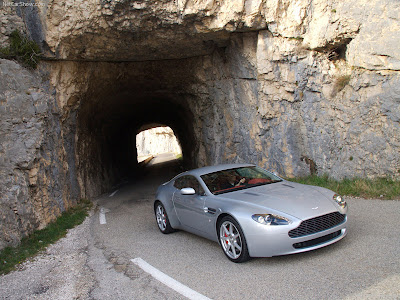
Aston Martin has again reinforced the new direction the company is taking by unveiling a spectacular concept car that is destined to become the most significant model in the company's 89-year history. Previously codenamed AM305, the Aston Martin AMV8 Vantage is the basis for a smaller third Aston Martin model, due to be launched in 2005, and will sit alongside the DB7 and the flagship Vanquish. The AMV8 Vantage will be hand-assembled at Aston Martin's state-of-the-art production facility at Gaydon, in the United Kingdom, which is currently under construction. The name Vantage – which will also be adopted for the production version - was chosen due its long historic links with Aston Martin. This time it's a specific model name rather than denoting a high performance version. The AMV8 Vantage is a tailored two-seater sports car that retains a front mid-engine/rear-wheel drive layout. Its design work was undertaken by Henrik Fisker, Aston Martin's Design Director, and his key objective was to produce a thoroughly modern Aston Martin. Another aim was to ensure that the interior layout and equipment were unique to Aston Martin and could be easily carried over into the production car. There are also a number of traditional Aston Martin design cues which have been incorporated into the AMV8 Vantage's styling such as the front grille shape and the typical side strakes found on all Aston Martin models.
Labels: Aston Martin, Concept Cars, engine, model, vantage, Wallpapers, wheel
The Aston Martin DBR9 is a racing car by Aston Martin Racing, first built in 2005. The name DBR9 is derived from the original 24 Hours of Le Mans-winning DBR1 car, named for then-owner David Brown, which not only won the 24 Hour race in 1959 but also the World Sportscar title. For the first time since 1959, Aston Martin has triumphed at Le Mans. The winning Aston Martin Racing with InterContinental Hotels & Resorts DBR9 – numbered 009 – was driven to GT1 class victory and a remarkable fifth overall by David Brabham, Rickard Rydell and Darren Turner after 24 hours of non-stop competition, characterised by changeable conditions and several safety car periods. The bad weather was in evidence right from the start of the first qualifying session, where the AMR Larbre Competition 008 DBR9 claimed pole position – before going on to finish third in the actual race. Aston Martin's double podium underlined the impressive performance and reliability of the DBR9, which is closely based on the DB9 road car. The winning 009 car started from fourth on the grid at 1500 on Saturday, and was locked in a fierce battle for the lead with its sister 007 car for the majority of the race. As night fell, the two Aston Martin Racing cars were separated by less than 10 seconds, and they were in visual contact with each other right up until dawn on Sunday morning. Then, the 007 car – crewed by Thomas Enge, Johnny Herbert and Peter Kox – had a small off-road excursion that nonetheless damaged the front splitter and necessitated an eight-minute repair. While pushing hard to make up the deficit, the 007 car went off again while trying to overhaul the third-placed competitor at around 0700 on Sunday. This seemingly innocuous trip into the gravel trap caused a series of related problems as the sharp flint stones in the gravel trap damaged the tyres, brakes, and alternator pulley. After a number of pit stops, the 007 car was forced to settle for fourth place in class. In total, there were six DBR9s entered for this year's 75th Le Mans 24 Hours – two each for Aston Martin Racing and AMR Larbre Competition, plus single-car entries from AMR BMS and Team Modena. All six cars made the finish, with AMR BMS ending up sixth in class and 11th overall, while Team Modena were 10th in class after their DBR9 was hit from behind by an LMP2 prototype at around 0300. This meant that the Team Modena DBR9 spent the best part of half an hour in the garage – having previously been fourth in class – before returning to the fray. The final 006 car run by Larbre was rewarded with 13th in class after a solid run through conditions that caught out many more experienced competitors. The winning crew of Brabham, Rydell and Turner experienced no major problems during the race, apart from the changeable weather that made tyre choice a permanent lottery. After a wet opening afternoon and a largely dry night, the rain returned with a vengeance at the very end of the race. David Brabham, who drove the final stint in a torrential downpour, said: 'I think that last lap this year was the longest of my entire life. The quantity of standing water made judging the amount of grip available a complete gamble. I just took a lot of care to bring the car home safely, and I think this result is a fantastic culmination of all the hard work not just from myself, Darren and Rickard, but also from the entire team.' Rickard Rydell – who was instrumental in making sure that the car got through the tricky early hours of the morning, with fog and mist in evidence – commented: 'It's been very nice to be here with such a good and professional team. To win like this is very special.' Darren Turner's efforts included a monumental triple stint on Saturday evening that lasted just under three hours. The Englishman commented: 'It's been a fantastic 24 hours. Having been involved in the Aston Martin Racing programme from the very start in 2005, Le Mans was always a bit of unfinished business for me. Now we've finally done it, which makes it a very special day for everybody at Aston Martin.' As the drivers sprayed champagne from the famous Le Mans podium in the pouring rain on Sunday, the accolades also flowed from Aston Martin's management. David Richards, Aston Martin's Chairman, said: 'To see Aston Martin winning at Le Mans again, nearly 50 years after our last famous victory, is a truly magnificent achievement for everybody associated with Aston Martin across the world.' Dr Ulrich Bez, Aston Martin's Chief Executive, commented: 'Since our last victory here in 1959, Le Mans has been dominated by several other great marques. But this year we had more cars than any other manufacturer and they all finished: six out of six, including the GT1 winner. It's been as truly historic day for Aston Martin and I am absolutely delighted.' The 1959 Le Mans-winning DBR1 appeared at the Legends race in Le Mans on Saturday morning before the start of the main event, driven by Sir Stirling Moss and Dr Bez. Now, 48 years later, the victorious Aston Martin DBR9 will next appear at the Goodwood Festival of Speed in Britain from June 23-24.
Labels: Aston Martin, Aston Martin DB9, racing, Series, speed, Used Car

Independent rally teams will soon be able to compete in the world's most exclusive rally car, the Aston Martin Rally GT. The new car has been developed by Aston Martin Racing, a partnership between Prodrive and Aston Martin. The Rally GT is based on the Aston Martin V8 Vantage, but extensively re-engineered by Prodrive. The motorsport specialist has combined its experience of running the Aston Martin DBR9s in international sports car racing with more than 20 years of rallying experience, to create this new car. As part of its development programme, the Rally GT has already competed in three French Rally Championship events, coming second in the Series GT class on its debut at the Lyon to Charbonniers Rally. As with the DBR9, the Rally GT uses a standard road car chassis which is fitted with a Prodrive-designed roll cage for safety and increased torsional rigidity. The engine is closely based on the all alloy road car 4.3 litre V8 unit but has been tuned to make it more flexible and responsive for the demands of rallying. The suspension on the Rally GT carries over the road car's wishbones, but has new competition Eibach springs and three-way adjustable EXE-TC dampers. The standard road car transmission is kept on the rally car, but this can be upgraded to a six-speed, close ratio dog engagement gearbox, developed specifically for the Rally GT. A limited number of Rally GTs will be produced by Aston Martin Racing and the first cars will be available at the end of 2006.
















